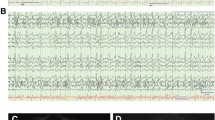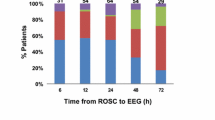Abstract
Background
Reactive electroencephalography (EEG) background during therapeutic hypothermia (TH) is related to favorable prognosis after cardiac arrest (CA), but its predictive value is not 100 %. The aim of this study was to investigate outcome predictors after a first reactive EEG recorded during TH after CA.
Methods
We studied a cohort of consecutive comatose adults admitted between February 2008 and November 2012, after successful resuscitation from CA, selecting patients with reactive EEG during TH. Outcome was assessed at three months, and categorized as survivors and non-survivors (no patient was in vegetative state). Demographics, clinical variables, EEG features, serum neuron-specific enolase (NSE) and procalcitonin, were compared using uni- and multivariable analyses.
Results
A total of 290 patients were treated with TH after cardiac arrest; 146 had an EEG during TH, which proved reactive in 90 of them; 77 (86 %) survived and 13 (14 %) died (without recovery from coma). The group of non-survivors had a higher occurrence of discontinuous EEG (p = 0.006; multivariate analysis p = 0.026), and a higher serum NSE peak (p = 0.021; multivariate analysis p = 0.014); conversely, demographics, and other clinical variables including serum procalcitonin did not differ.
Conclusions
A discontinuous EEG and high serum NSE are associated with mortality after CA in patients with poor outcome despite a reactive hypothermic EEG. This suggests more severe cerebral damage, but not to higher extent of systemic disease.
Similar content being viewed by others
References
Scirica BM. Therapeutic hypothermia after cardiac arrest. Circulation. 2013;127(2):244–50.
The Hypothermia After Cardiac Arrest Study Group. Mild therapeutic hypothermia to improve the neurologic outcome after cardiac arrest. N Engl J Med. 2002;346(8):549–56.
Bernard SA, Timothy GW, Buist M, et al. Treatment of comatose survivors of out-of-hospital cardiac arrest with induced hypothermia. N Engl J Med. 2002;346(8):557–63.
Hörburger D, Testori C, Sterz F, et al. Mild therapeutic hypothermia improves outcomes compared with normothermia in cardiac-arrest patients—a retrospective chart review. Crit Care Med. 2012;40(8):2315–9.
Fugate JE, Brinjikji W, Mandekar JN, et al. Post-cardiac arrest mortality is declining: a study of the US National Inpatient Sample 2001 to 2009. Circulation. 2012;126:546–50.
Rossetti AO, Oddo M, Logroscino G, Kaplan PW. Prognostication after cardiac arrest and hypothermia: a prospective study. Ann Neurol. 2010;67(3):301–7.
Fugate JE, Wijdicks EFM, Mandrekar J, et al. Predictors of neurologic outcome in hypothermia after cardiac arrest. Ann Neurol. 2010;68:907–14.
Cronberg T, Rundgren M, Westhall E, et al. Neuron-specific enolase correlates with other prognostic markers after cardiac arrest. Neurology. 2011;77(7):623–30.
Rundgren M, Karrisonn T, Nielsen N, Cronberg T, Johnsson P, Friberg H. Neuron specific enolase and S-100B as predictors of outcome after cardiac arrest and induced hypothermia. Resuscitation. 2009;80(7):784–9.
Oh SH, Park KN, Kim YM, et al. The prognostic value of continuous amplitude-integrated electroencephalogram applied immediately after return of spontaneous circulation in therapeutic hypothermia-treated cardiac arrest patients. Resuscitation. 2013;84(2):200–5.
Rossetti AO, Carrera E, Oddo M. Early EEG correlates of neuronal injury after brain anoxia. Neurology. 2012;78(11):796–802.
Annborn M, Dankiewicz J, Erlinge D, et al. Procalcitonin after cardiac arrest—an indicator of severity of illness, ischemiareperfusion injury and outcome. Resuscitation. 2013;84(6):782–7.
Engel H, Hamouda NB, Portmann K, et al. K. et al. Serum procalcitonin as a marker of post-cardiac arrest syndrome and long-term neurological recovery, but not of early-onset infections, in comatose post-anoxic patients treated with therapeutic hypothermia. Resuscitation. 2013;84(6):776–81.
European Resuscitation Council, American Heart Association. Heart and Stroke Foundation of Canada, and Australian Resuscitation Council. Recommended guidelines for uniform reporting of data from out-of-hospital cardiac arrest (new abridged version). The “Utstein Style”. Br Heart J. 1992;67:325–33.
Hirsch LJ, Brenner RP, Drislane FW, et al. The ACNS Subcommittee on Research Terminology for Continuous EEG Monitoring: proposed Standardized Terminology for Rhythmic and Periodic EEG Patterns Encountered in Critically Ill Patients. J Clin Neurophysiol. 2005;22(2):128–35.
Banasiak KJ, Xia Y, Haddad GG. Mechanisms underlying hypoxia-induced neuronal apoptosis. Prog Neurobiol. 2000;62(3):215–49.
Rossetti AO, Urbano LA, Delodder F, Kaplan PW, Oddo M. Prognostic value of continuous EEG monitoring during therapeutic hypothermia after cardiac arrest. Crit Care. 2010;14(5):173.
Bouwes A, Binnekade JM, Kulper MA, et al. Prognosis of coma after therapeutic hypothermia: a prospective cohort study. Ann Neurol. 2012;71(2):206–12.
Steffen IG, Hasper D, Ploner CJ, et al. Mild therapeutic hypothermia alters neuron specific enolase as an outcome predictor after resuscitation: 97 prospective hypothermia patients compared to 133 historical non-hypothermia patients. Crit Care. 2010;14(2):R69.
Azzopardi VD, Strohm B, Edwards AD, et al. Moderate Hypothermia to treat perinatal asphyxia encephalopathy. N Engl Med. 2009;361:1349–58.
Acknowledgments
The authors thank Christine Stähli, RN, Dr. Alba Sierra, the EEG fellows and technologists, and the ICU fellows, for their help in data collection.
Disclosures
The Swiss National Science Foundation provides financial support to AOR (CR32I3_143780) and MO (320030_138191).
Author information
Authors and Affiliations
Corresponding author
Rights and permissions
About this article
Cite this article
Tsetsou, S., Oddo, M. & Rossetti, A.O. Clinical Outcome After a Reactive Hypothermic EEG Following Cardiac Arrest. Neurocrit Care 19, 283–286 (2013). https://doi.org/10.1007/s12028-013-9883-5
Published:
Issue Date:
DOI: https://doi.org/10.1007/s12028-013-9883-5




